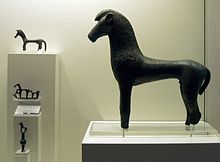Sculpture of a horse (Olympia B 1741)
The sculpture of a horse is an early archaic bronze sculpture. It was found during excavations in Olympia in 1939 and is located under inventory number B 1741 in the Olympia Archaeological Museum . The time of origin is the early 7th century BC. Dated.
The sculpture is 45.5 cm high and 47 cm long, it was found during excavations in a highly archaic well under the mosaic hall of the Nero House . It is badly bumped, but largely completely preserved, only the ends of the legs and tail are broken off. The curved tail was completely broken off but was reattached to the figure. Originally, the sculpture was over half a meter high.
The horse is rated as artistically and stylistically undemanding and its formal execution as unsatisfactory, but as a single item it is of great interest from an art-historical perspective. It is a unique transitional work between the small format of the geometrical style and the larger format of the archaic, in which an attempt was made to enlarge a figure using traditional technology. The figure was made in full casting from two parts, which were then joined together. Since the full casting technique is not suitable for sculptures of this size, the attempt to connect the two parts without a visible transition also failed. In addition, the individual parts also have casting defects. Attempts like these, in which it was not successful to execute small geometric sculptures in a larger format, probably led to the development of hollow casting in the course of the 7th century BC. Contributed significantly. As the only preserved work of its kind, it is of great importance for the history of ancient ore casting. It may have been an attempt to erect a memorial to a horse that had won the Olympic Games .
literature
- Hans-Volkmar Herrmann : horse . In: Alfred Mallwitz , Hans-Volkmar Herrmann (ed.): The finds from Olympia . German Archaeological Institute, Athens 1980, pp. 125–126.
- Wolf-Dieter Heilmeyer : Early Olympic bronze figures. The animal votive (= Olympic Research , Volume 12). De Gruyter, Berlin 1979, ISBN 3-11-007208-4 , pp. 167-170.
Web links
- Early Archaic bronze statuette of a stallion in the Arachne archaeological database
